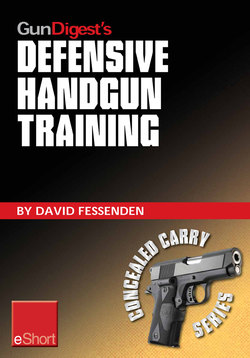Читать книгу Gun Digest's Defensive Handgun Training eShort - David Fessenden - Страница 3
ОглавлениеDry practice – practicing various drills with an unloaded gun – is the best way to build familiarity with your chosen weapon.
As I have stated in previous chapters, the most common sin committed by prospective gun owners who wish to purchase a handgun for personal protection is to buy the gun, take it to a gun range and load up a couple of rounds in it, fire them at a paper target and go home and secure the gun in their nightstand or gun safe. They believe they are all “tuned up” for the robber, should he attempt a home invasion in the middle of the night.
Such people are sadly mistaken. Unfortunately, this is often the rule rather than the exception. Remember what I said about the deterioration of the fine motor skills during times of extreme stress, fear and anxiety? They vanish instantly, and simple tasks like reaching to open a drawer in your dresser top become very difficult. It is during a response to a threat that very bad things will happen, things that can affect the outcome and determine whether you survive in this situation. Even if you have trained diligently for this moment and your reflexive training takes over, you will find these life-saving techniques difficult to perform under the stress this threat to you generates. It all goes to the question, “If you have never performed this feat, how are you going to be able to accomplish it when the well-known substance hits the fan?”
If you are at all serious about your personal protection and your ability to survive a possible gunfight, you need to have undergone a minimum of 50 hours of professional firearms instruction at one of the better-known training schools anywhere in the country, soon after the purchase of your firearm. Fifty hours constitutes a lengthy four-day class or a week-long class at any of several schools.
Now, let’s talk about the type of school you should be looking into. As an example, if you were looking to learn to drive a racecar would you be looking at a school that offers a course in how to drive heavy equipment? Of course not. Same with firearms training: you should be looking for a school that offers a two- or four-day defensive handgun course in its curriculum. There are many fine schools out there with an excellent staff of instructors on them, but you need to investigate their backgrounds. Many former Green Berets, SEALs, law enforcement officers and competitive shooters have founded excellent training schools, but what do they teach? That which they know best. Therefore they cater to military, law enforcement departments and competitive shooters. Just seems right, doesn’t it? They teach a lot of CQB (close quarters battle) techniques, advanced tactics and other martial techniques that will be too advanced for the average new gun owner or beginning shooter.
Remember, look for the defensive handgun classes in their curriculum before applying. After you have completed your two- and four-day defensive handgun course, you will be prepared to take one of these advanced tactical courses, if your interests take you in that direction. You will have a firm, basic foundation of understanding in defensive handgun techniques upon which to build.
Performed at the right time and in a separate session, trigger control is an essential part of dry practice.
The Basics
In your four-day defensive handgun course you should be taught, and should develop, a mastery of chamber checking, unloading and loading, stance and grip, after-action drills, the presentation, malfunction drills, and Failure to Stop drills. Home Invasion scenarios and Shoot House exercises should also be part of any good curriculum. Practicing shooting multiple targets, range commands, range safety, night shooting and a good dose of basic marksmanship techniques will enable you to consistently get good hits on the target and will round out your training. In addition, many schools have, as part of the four-day course, an entire afternoon devoted to shooting from concealment.
Dry Practice
Apart from all this good stuff in the class, you will gain an appreciation for the merits of setting up a strict weekly dry practice regimen, so as to not lose the edge on the skills you have worked so hard to attain while attending the class. Dry practice is the method by which you continue to hone your newly acquired skills and elevate them to the next level.
Dry practice means going through the drill strokes of a given gun handling technique with an empty firearm (emphasis on the “empty” part)! You would of course perform several chamber checks and remove the magazine and any and all ammunition from your dry practice area, prior to starting your dry practice sessions. For the serious handgunner, dry practice will program your future response to a possible life-threatening situation. Cooper often stated, “Your shooting is a programmed reflex and you program it only by familiarity.”
There are several instructors who believe and teach instinctive or point shooting. It consists of drawing and shooting from the hip or, at best, in a crouched position with the weapon extended a short distance from the body. The shooter does not acquire a sight picture. In all honesty, this may be your only option for survival, if the adversary is within approximately three meters and obviously intends you serious harm. If you have the opportunity, however, get that front sight in focus and take two well-aimed thoracic cavity shots to stop his attack. Dry practice builds the ability to perform this kind of response during your moment of great peril.
